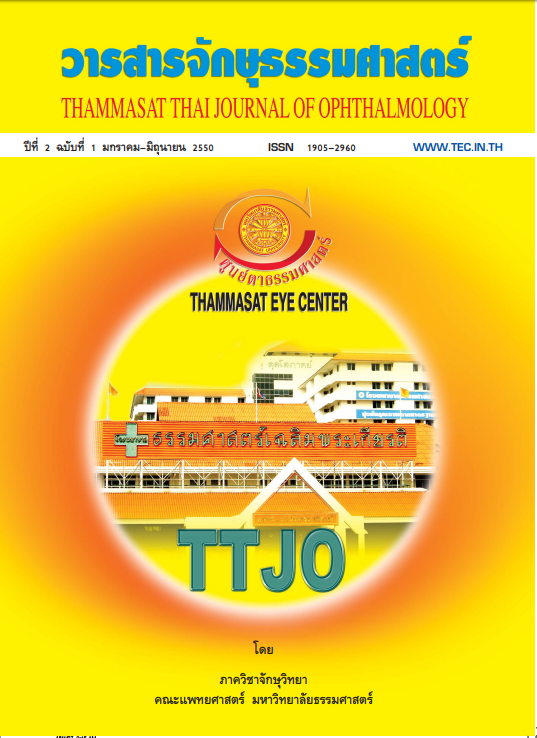Efficacy and Safety of Silicone Punctal Plug Treatment in Moderate to Severe Dry Eye at Thammasat University Hospital
Main Article Content
Abstract
Objective: To study the clinical efficacy and safety of lacrimal occlusion by silicone punctal plug in moderate to severe dry eye patient at Thammasat University Hospital.
Methods: 40 eyes from moderate to severe dry eye patients are included in the study. Dry eye grading is determined by one ophthalmologist. Silicone plug will be inserted in a lower punctum. One, two and four-week follow up are scheduled. We will compare the conjunctival Fluorescein staining before and after a punctal plug insertion. Patient satisfaction will be evaluated before and after a punctal plug insertion. Study designs: Prospective comparative study.
Results: Percent of dry eye grading by Oxford Scheme before a punctal plug insertion at one, two and four week in grade A, B, C, D, E and >E was 0, 0, 0, 60, 40, and 0% respectively. Percent of dry eye grading after a punctal plug insertion at one week was 42.5, 50, 2.5, 5, 0, and 0% respectively Percent of dry eye grading after a punctal plug insertion at two week was 65.8, 34.2, 0, 0, 0, and 0% respectively Percent of dry eye grading after a punctal plug insertion at four week was 73.7, 26.3, 0, 0, 0, and 0% respectively. The results revealed significant improvement of grading of dry eye after inserted silicone punctal plug in 1st, 2nd and 4th week. Comparing dry eye grading between pre-punctal insertion and 1st, 2nd and 4th week post-punctal insertion has been decreased significantly Percent of patient satisfaction grade 1, 2 and 3 in four week follow up was 0, 25 and 75% respectively.
Conclusions: The silicone punctal plug is safety and effective in treatment of moderate and severe dry eye. In some patients, qualities of life have been improved by treatment of the silicone punctal plug alone without using any tear supplements or other medications.
--------------------------------------------------
วัตถุประสงค์: เพื่อศึกษาประสิทธิผลทางคลินิก และความปลอดภัยของการอุดท่อน้ำตาด้วยซิลิโคน ในการรักษาผู้ป่าวยตาแห้งชนิดรุนแรงปานกลางถึงรุนแรงมากในโรงพยาบาลธรรมศาสตร์เฉลิมพระเกียรติ
วิธีการศึกษา: ผู้ป่วยโรคตาแห้งชนิดรุนแรงปานกลางถึงรุนแรงมากในโรงพยาบาลธรรมศาสตร์เฉลิมพระเกียรติจำนวน 20 คน 40 ตา เข้าร่วมการวิจับโดยทำการประเมินภาวะตาแห้งโดยจักษุแพทย์ท่านเดียวใช้ซิลิโคนอุดท่อน้ำตาที่รูเปิดน้ำตาด้านล่าง ทำการตรวจประเมินภาวะตาแห้งหลังการรักษา 1,2 และ 4 อาทิตย์ โดยทำการตรวจประเมินภาวะตาแห้งด้วยการใช้สีฟูลออเรสเซนส์ย้อมที่กระจกตา และประเมินความพึงพอใจของผู้ป่วยก่อนและหลังการรักษา
ผลการวิจัย: สัดส่วนของผู้ป่วยที่มีภาวะตาแห้งก่อนทำการรักษาโดยใช้ซิลิโคนอุดท่อน้ำตาแบ่งตามความรุนแรงเป็น A, B, C, D, E และ >E คิดเป็นร้อยละ 0, 0, 0, 60, 40 และ 0 ตามลำดับ สัดส่วนของผู้ป่วยที่มีภาวะตาแห้งหลังทำการรักษาโดยการใช้ซิลิโคนอุดท่อน้ำตาอาทิตย์ที่ 1 คิดเป็นร้อยละ 42.5, 50, 2.5,5, 0 และ 0 ตามลำดับ สัดส่วนของผู้ป่วยที่มีภาวะตาแห้งหลังทำการรักษาโดยการใช้ซิลิโคนอุดท่อน้ำตาอาทิตย์ที่ 2 คิดเป็นร้อยละ 65.8, 34.2, 0, 0, 0 และ 0 ตามลำดับ สัดส่วนของผู้ป่วยที่มีภาวะตาแห้งหลังทำการรักษาโดยการใช้ซิลิโคนอุดท่อน้ำตาอาทิตย์ที่ 4 คิดเป็นร้อยละ 73.7, 26.3, 0, 0, 0 และ 0 ตามลำดับ
จากผลการวิจัยพบมีการเปลี่ยนแปลงของภาวะตาแห้งดีขึ้นอยา่างชัดเจนหลังการรักษาโดยการใช้ซิลิโคนอุดท่อน้ำตา ผลการเปรียบเทียบความพึงพอใจของผู้ป่วยหลังการรักษาโดยการใช้ซิลิโคนอุดท่อน้ำตาหลังรักษาโดยการใช้ซิลิโคนอุดท่อน้ำตา 1, 2 และ 4 อาทิตย์ คิดเป็นร้อยละ 0, 25 และ 75 ตามลำดับ
สรุปผลการวิจัย: การใช้ซิลิโคนอุดท่อน้ำตาในการรักษาผู้ป่วยตาแห้งชนิดรุนแรงปานกลางถึงรุนแรงมากมีประสิทธิภาพและความปลอดภัยสูง อีกทั้งยังเป็นการพัฒนาคุณภาพชีวิตให้แก่ผู้ป่วยโรคตาแห้งชนิดรุนแรงปานกลางถึงรุนแรงมากอีกด้วย
Article Details
References
Bron AJ, Evans VE, Smith JA. Grading of Corneal and Conjunctival Staining in the context of other Dry Eye Tests, Cornea 2003 Oct; 22(7):640-50.
Sm artPlug Study Group. Management of complications after insertion of the SmartPlug Punctal Plug. Ophthalmology 2006 Aug 18; [Epub ahead of print]
Koh S, Maeda N, Ninomiya S, Watanabe H, Fujikado T, Tano Y, Hirohara Y, Mihashi T. Paradoxical increase of visual impairment with punctal occlusion in a patient with mild dry eye. J Cataract Refract Surg. 2006 Apr; 32(4):689-91.
Musadiq M, Mukherji S, Sandramouli S. Pyo genic granuloma following silicone punctal plugs: report of two cases. Orbit. 2005 Jun; 24(2):149-51. Efficacy and Safety of Silicone Punctal Plug Treatment in Moderate to Severe Dry Eye at Thammasat University 20
Altan-Yaycioglu R, Gencoglu EA, Akova YA, Dursun D, Cengiz F, Akman A. Silicone versus
collagen plugs for treating dry eye: results of a prospective randomized trial including lacrimal scintigraphy. Am J Ophthalmol 2005 Jul;140(1):88-93.
Kim BM, Osmanovic SS, Edward DP. Pyogenic granulomas after silicone punctal plugs : a clinical and histopathologic study. Am J Ophthalmol 2005 Apr;139(4):678-84.
Hsu HC. Ampullary pyogenic granuloma as a complication of lacrimal plug migration. Chang Gung Med J. 2002 Jun; 25(6):415-8.
Tai MC, Cosar CB, Cohen EJ, Rapuano CJ, Laibson PR. The clinical efficacy of silicone punctal plug therapy. Cornea 2002 Mar; 21(2):135-9.
Mandelkorn RM. Silicone punctal plug extrusion. Ophthalmology 2001 Dec; 108(12): 2154-5.
Soparkar CN, Patrinely JR. Silicone punctal plug extrusion. Ophthalmology 2001 Dec; 108(12):2153-4.
John T, Kopstein AB, John OC, Lai CI, Carey RB. In vitro adherence of Staphylococcus epidermidis to silicone punctual plugs and collagen implants. Journal of Cataract Refract Surgery. 2001 Aug; 27(8):1298-302.
Guzey M, Ozardali I, Kilic A, Basar E, Dogan Z, Satici A, Karadede S. The treatment of severe trachomatous dry eye with canalicular silicone plugs. Eye. 2001 Jun; 15(Pt 3): 297-303.
Balaram M, Schaumberg DA, Dana MR. Efficacy and tolerability outcomes after punctal occlusion with silicone plugs in dry eye syndrome. Am J Ophthalmol 2001 Jan; 131(1):30-6.


